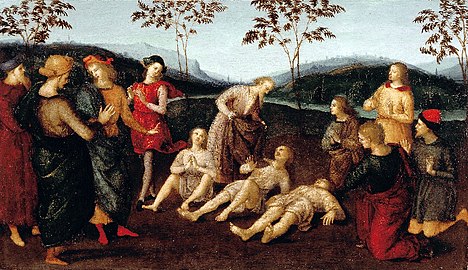Mond Crucifixion
| Crucifixion with the Virgin, Saints and Angels | |
|---|---|
National Gallery, London |
The Mond Crucifixion or Gavari Altarpiece is an oil on
Background
This early work by Raphael was commissioned by the wool merchant Domenico Gavari as the
Main panel
The main panel portrays the
The two kneeling figures are both reverently contemplating Jesus on the cross, while the two standing figures are wringing their hands while looking out at the viewer. A panel at the top of the cross bears the inscription "
The main panel measures 283.3 cm × 167.3 cm (111.5 in × 65.9 in) and is now housed in a 19th-century frame.[1] The geometrical precision of the composition suggest it was laid out using a grid, using a rule and compasses to copy from a preparatory drawings. A drawing of a kneeling person, perhaps a study for the figure of Mary Magdalene, is held by the Ashmolean Museum in Oxford.[2]
The painting was influenced by
Predella
The two surviving panels of the predella each measure approximately 26 cm × 43 cm (10 in × 17 in) and depict miracles from the life story of Saint Jerome from the Hierominianum of Giovanni d'Andrea. Saint Jerome lived in the late 4th and early 5th century AD, so he could not have attended the crucifixion, but he is portrayed here as the patron saint of the chapel.
One of the surviving predella panels has been in the
The other surviving predella panel is in the North Carolina Museum of Art in Raleigh, North Carolina. It depicts Saint Jerome saving Silvanus and punishing the Heretic Sabinianus. Saint Jerome is holding back the arm of the executioner ready to behead bishop Silvanus, but the heretic Sabinianus has been miraculously decapitated instead.[4]
-
Eusebius of Cremona raising Three Men from the Dead with Saint Jerome's Cloak,Museu Nacional de Arte Antiga, Lisbon
-
Saint Jerome saving Silvanus and punishing the Heretic Sabinianus, North Carolina Museum of Art, Raleigh, North Carolina
Provenance
The main panel was bought by
The predella panels seem to have been removed in the 17th century, and given as gifts to a visiting cardinal. The panel in North Carolina was formerly in the collection of Sir Francis Cook at Doughty House, Richmond, London.
Painting materials
The main panel was analyzed in the National Gallery London
See also
References
- ^ Studying Raphael: frames Archived 2019-03-31 at the Wayback Machine, National Gallery, London
- ^ Kneeling Figure of a Youth, Ashmolean Museum
- ^ The Miracle of St. Eusebius of Cremona, Museu Nacional de Arte Antiga
- ^ St. Jerome Saving Sylvanus and Punishing the Heretic Sabinianus Archived 2021-06-01 at the Wayback Machine, North Carolina Museum of Art
- ^ Roy, A., Spring, M., Plazzotta, C. ‘Raphael’s Early Work in the National Gallery: Paintings before Rome‘. National Gallery Technical Bulletin Vol 25, pp 4–35.
- ^ Raphael, The Mond Crucifixion, ColourLex
Sources
- The Mond Crucifixion, Raphael, National Gallery, London
- Henry, Tom. "Raphael's Altar-Piece Patrons in Città Di Castello", The Burlington Magazine, vol. 144, no. 1190, 2002, pp. 268–278
External links
 Media related to Mond Crucifixion at Wikimedia Commons
Media related to Mond Crucifixion at Wikimedia Commons


